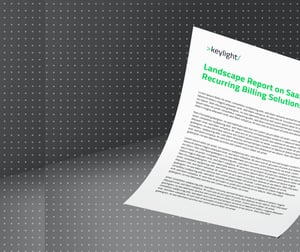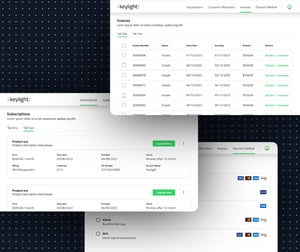Humanizing Subscription Businesses | Part three
![]() n our recent articles, we spoke about customer experience and the sales cycle, as well as the value of customer relationships. However, the third pillar of a successful subscription business is customer engagement.
n our recent articles, we spoke about customer experience and the sales cycle, as well as the value of customer relationships. However, the third pillar of a successful subscription business is customer engagement.
Here we wanted to take a look at customer engagement in subscription-based models, exploring the key touchpoints, traditional and digital processes, and comparing how they’re used in one-off sales environments vs subscription-based models.
Customer engagement is top priority
When we talk about engagement, we are referring to the emotional relationship that you build with your customers, created over time through the different opportunities for interaction. From the first moment a customer lands on your website, scrolls past an Instagram post, or picks up the phone to your call center, customer engagement begins. The challenge for businesses is understanding what’s important for your customers, collectively and individually, in relation to your product or service, both at the outset and as the relationship progresses along with the market around you.
At the start, before a customer has landed on your website, the information used in marketing (social media for example) will most likely be based on a comparatively broad demographic or market segmentation. However, once you have established direct communication, your opportunity for building a meaningful relationship grows.
A subscription business perspective
Customer engagement is important because highly engaged customers are shown to buy more, promote more, and demonstrate more loyalty. That makes the quality of those engagements an essential focus for any modern organization.
The key is having the data to understand your customers and what makes them happy, as well as the knowledge and systems to turn that data into meaningful actions.
An excellent customer experience also makes you much more resilient against industry disruptors - it is something that no one else will ever be able to replicate. They might copy your product or service, but the feedback you get as a company from an engaged customer base is unique to you.
Understanding customer engagement in subscription models is of particular importance for modern businesses, not just for those that start out as subscription-based models, but also for those seeking to compete in a changing marketplace. As a case in point, according to McKinsey the subscription e-commerce market has grown by more than 100% percent a year over the past five years.
Evolving from traditional to digital engagement
Traditionally, customer engagement has hinged on things like out-of-home advertising campaigns (OOH) including billboards, wallscapes, and posters, and POC (proof of concept) sales approach like demonstrations. More contemporary options capitalize on digital platforms including email, social media, websites, push notifications, live chat, and text messages.
The data and tools that we have available to us via the digital landscape give us far greater scope to engage with consumers and to understand their needs in order to improve their experience and your business outcomes.
However, despite having similar tools available, customer engagement in a subscription-based business requires a different emphasis and execution of customer engagement practices in a one-off sales environment. Often, this is where businesses seeking to enter or transition into the subscription model come up against challenges.
Trying to transplant the same methodologies from one to the other results in poor customer engagement, and poor customer experience and does not reap the business outcomes that they anticipate or want.
So, how does customer engagement differ in one-off sales vs subscription models?
One-off sales and customer engagement
Typically in a one-off sales environment, there are few touchpoints where businesses can engage with and learn about their customers. It might be as simple as a singular advert or campaign, where the majority of the customer’s deliberations are done offline.
This makes it almost impossible to measure genuine feedback. Many businesses try to address the problem with things like customer surveys. However, typically the resulting information is superficial and incomplete. Data tends to be disparate and not centrally collected or fed back into the customer journey and customer experience, acting as more of a box-checking exercise than a deep understanding of how customers are engaging with the brand, the sales team, and the product.
A typical business perspective might consider the main metric of significance in this scenario to be the number of sales. As a result, the engagement effort is sales-driven and based on assumptions rather than customer-centricity, while the ROI is calculated through top-level metrics, which are too general to truly understand the customer experience.
From a customer point of view, this approach tends to feel impersonal and provides a limited or highly transactional engagement with limited or no experiential value.
Subscription models and customer engagement
In a subscription-based business, digital interactions already provide companies with a huge advantage to engage with and understand their customers. There are far more touchpoints, which makes for many more opportunities for engagement and learning for long-term improvements.
For example:
- Engagement can happen throughout the entire customer lifecycle.
- Businesses can offer a self-service portal for customers to have more control over their subscriptions and can engage on their own terms.
- Data can be collected by different systems allowing businesses to monitor the engagement more effectively, optimize campaigns, and analyze and predict how the relationship evolves over time.
However, all of this also makes it a much more complicated and refined process in order to gather the right data, process it, and transform it into improved experiences and relationships.
Contemporary issues & challenges
Timing
Timing is an often overlooked issue when it comes to customer engagement, but as with so many things, timing is everything. Customer journeys can be diverse, changing over time, and when the right data is not being collected, businesses can’t know what and when to engage beyond very functional information like when payment information needs to be updated.
A lot of systems barely collect this kind of data because they’re mostly designed for commerce and billing rather than focusing on people. As a result, businesses don’t know when they need to engage with a customer so they can prevent churn or encourage them to upgrade. If you collect the right data, you can make predictions about customer actions. For example, if they haven’t engaged within a certain amount of time you can offer a proper campaign or discount before they move to the churn path, engaging in time and bringing them back to the happy customer path.
Technology
We often find that people start their subscription business by looking at a billing system. In our previous articles, you will have heard us talk about how subscription businesses are often conflated with repeat income. While the two often go together, by making billing the focal point of the business instead of the customer, companies frequently start with the wrong mindset and make poor choices that ultimately negatively impact the customer. In particular, this tends to relate to systems and technology.
When businesses don’t have the right systems in place, or where they have tried to integrate systems that are not designed to work together, customers tend to have a clunky experience and teams usually find that the data they are given becomes overwhelming.
This makes it almost impossible to use it to engage with customers at the right time and improve the customer experience.
Ultimately, the systems are not built for people to engage with each other, but for finance and products. For effective and positive customer engagement, systems need to connect properly, allowing teams to juggle customers and products through a subscription ecosystem that works.
Rethink customer engagement for subscriptions
Successful customer engagement is about wanting to help customers get the very most out of your product or service rather than flagrantly seeing each customer as a target on a sales chart. That’s a question of mindset, allowing you to take a holistic view of the customer journey, and implement an end-to-end user-centric approach.
That means that data is collected from the customer journey and that systems are built for users to interact with one another. As a result, businesses have more resources to develop good products and strategies for customer engagement.
At keylight, we enable businesses to build a two-way relationship with customers. They can engage at the right time, while still giving customers control along their subscriber lifecycle to engage with the business on their own terms.

Excel in customer engagement
with effective and modern strategies
Start now with >keylight/




